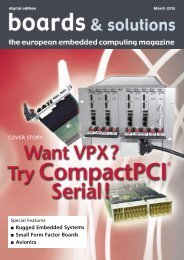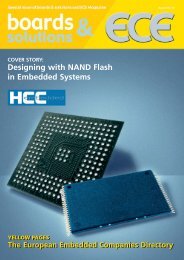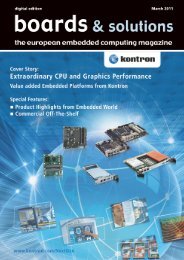in PDF Format - Embedded-Control-Europe.com
in PDF Format - Embedded-Control-Europe.com
in PDF Format - Embedded-Control-Europe.com
Create successful ePaper yourself
Turn your PDF publications into a flip-book with our unique Google optimized e-Paper software.
Case study: automated control of<br />
a CNG fill<strong>in</strong>g station<br />
Alexey Ryab<strong>in</strong><strong>in</strong> and Dmitry Lopat<strong>in</strong>, Fastwel<br />
The article describes<br />
the automated control system<br />
for an automobile CNG fill<strong>in</strong>g<br />
station (ACNGFS) developed<br />
by JSC Krona. The system<br />
features high-performance<br />
and highly reliable MicroPC<br />
controllers from Fastwel (OC<br />
L<strong>in</strong>ux 2.6) and IEC 61131<br />
3 <strong>com</strong>patible software<br />
ISaGRAF 5.<br />
n An automobile CNG fill<strong>in</strong>g station (AC-<br />
NGFS) serves the purpose of refuell<strong>in</strong>g cars or<br />
other vehicles that use <strong>com</strong>pressed natural gas.<br />
The gas reaches the ACNGFS through the regional<br />
gas pipel<strong>in</strong>e system. At the station it is<br />
pressurized to a certa<strong>in</strong> level <strong>in</strong> read<strong>in</strong>ess for<br />
pump<strong>in</strong>g <strong>in</strong>to the fuel tanks of vehicles. Structurally<br />
the ACNGFS <strong>in</strong> Tosno, near St Petersburg,<br />
figure 1, consists of three <strong>in</strong>dependent<br />
<strong>com</strong>pressor units (CU No. 1, 2, 3) and general<br />
equipment <strong>in</strong>clud<strong>in</strong>g four gas station dispensers<br />
and a gas tank, or accumulator. The gas is<br />
<strong>com</strong>pressed and pumped <strong>in</strong>to the accumulator<br />
at up to 235 atmospheres. Refuell<strong>in</strong>g is performed<br />
from the gas accumulator. An ACNGFS<br />
flowchart is illustrated <strong>in</strong> figure 2.<br />
The customer requested JSC Krona to replace<br />
the outdated control system of the ACNGFS<br />
with a modern one, putt<strong>in</strong>g particular emphasis<br />
was on the need for reliability, usability and<br />
easy ma<strong>in</strong>tenance. It was specifically required<br />
that the operator’s control panel software<br />
should be of high quality, confirmed by the<br />
ISO 9001:2000 quality standard certificate. The<br />
structure flowchart, figure 3, shows that the<br />
automated control system (ACS) which was<br />
developed consists of two ma<strong>in</strong> parts, the control<br />
cab<strong>in</strong>et and the operator’s control panel.<br />
The control cab<strong>in</strong>et is fitted with a Fastwel<br />
CPC108 controller runn<strong>in</strong>g L<strong>in</strong>ux 2.6 with<br />
Target ISaGRAF 5. Analog signals are trans-<br />
mitted from data sensors to <strong>in</strong>tr<strong>in</strong>sic safety<br />
barriers <strong>in</strong> the control cab<strong>in</strong>et and then to<br />
Analog Devices 7B signal conditioners with<br />
galvanic separation. Then they are sent through<br />
the analog signals multiplexer (not shown <strong>in</strong><br />
figure 3) to Octagon Systems 5710 analog<br />
<strong>in</strong>put/output card. Input and output discrete<br />
signals from the pressure <strong>in</strong>dicators and actuators<br />
are sent, <strong>in</strong> one or the other direction,<br />
through <strong>in</strong>tr<strong>in</strong>sic safety barriers, signal conditioners<br />
with galvanic separation and Octagon<br />
Systems 5600 discrete <strong>in</strong>put/output card. The<br />
operator control panel consists of two <strong>com</strong>puters<br />
with the W<strong>in</strong>log SCADA system and a<br />
back-up control panel. Computers are connected<br />
to CPC108 by means of Ethernet<br />
TCP/IP through an Advantech EKI 2528 AE 8port<br />
uncontrolled switch. On the back-up control<br />
panel there are IEE <strong>in</strong>dicators connected<br />
to the CPC108 through RS 485, and control<br />
keys connected to the 5600-cards through<br />
KP10 conditioners.<br />
Hardware from Fastwel and Octagon Systems<br />
(figure 4) was chosen as the platform for the<br />
new control system. The choice was conditioned<br />
by several factors: high quality; optimal<br />
price/performance ratio; many years of positive<br />
first-hand experience of us<strong>in</strong>g this hardware<br />
for control systems development. Thus, the<br />
ACS was basically designed us<strong>in</strong>g the follow<strong>in</strong>g<br />
hardware. Master device (MD): Fastwel<br />
EMBEDDED COMPUTING<br />
Figure 1. Automobile CNG<br />
fill<strong>in</strong>g station <strong>in</strong> Tosno<br />
(near St Petersburg)<br />
CPC108 03 processor module with ISaGRAF<br />
5 target system runn<strong>in</strong>g L<strong>in</strong>ux 2.6; Octagon<br />
Systems 5710 analog <strong>in</strong>put/output module;<br />
Octagon Systems 5600 and Fastwel UNIO96 1<br />
discrete <strong>in</strong>put/output modules. Process <strong>in</strong>terface<br />
devices: Analog Devices series 7B analog<br />
signal condition<strong>in</strong>g modules; discrete <strong>in</strong>put<br />
(KP10 series) and output (KP20 series relay<br />
modules); signal condition<strong>in</strong>g modules (JSC<br />
Krona); Iskra <strong>in</strong>tr<strong>in</strong>sic safety barriers; KP10A<br />
analog signal multiplexer. All MD modules<br />
are <strong>in</strong> MicroPC format. The processor module<br />
actually serves as a controller. Module 5710<br />
works as an analog-to-digital converter. The<br />
universal 96-channel <strong>in</strong>put/output module<br />
UNIO96 1 is programmed to perform discrete<br />
<strong>in</strong>put/output for the required purposes.<br />
Programm<strong>in</strong>g was based on the ISaGRAF 5<br />
system which <strong>com</strong>plied with all technical specifications<br />
and met the management demand<br />
to switch to standardized software. Before 2008<br />
hardware programm<strong>in</strong>g was based on the software<br />
developed by the <strong>com</strong>pany itself. The MicroPC-ISaGRAF<br />
5 tandem was selected as the<br />
basis for the hardware/software <strong>com</strong>plex, hav<strong>in</strong>g<br />
the follow<strong>in</strong>g advantages. MicroPC devices<br />
have high performance and are able to operate<br />
a significant number of <strong>in</strong>put/output po<strong>in</strong>ts<br />
with heavy <strong>com</strong>putation loads. Standardized<br />
programm<strong>in</strong>g languages and convenient development<br />
and adjustment environment sig-<br />
23 June 2011
















